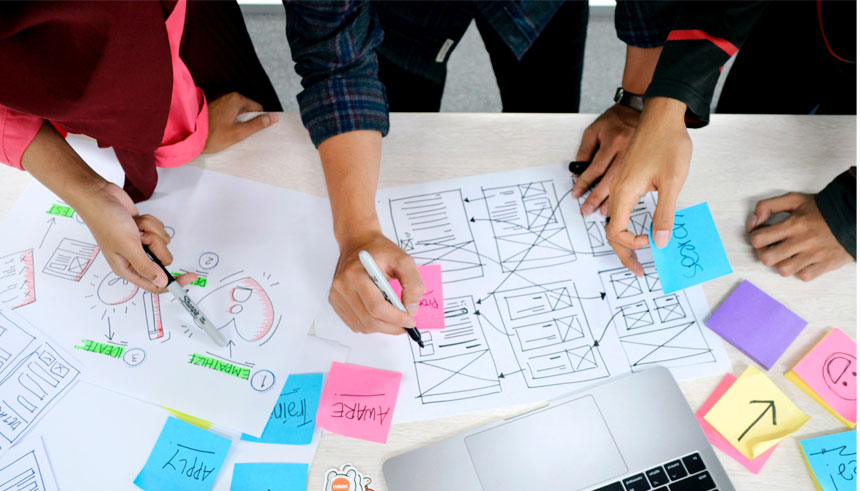At a time of accelerating technological change and increasing competition among companies, innovation is no longer a luxury; it has become a prerequisite for survival and growth. However, arriving at new solutions does not happen by chance, but rather by adopting different thinking approaches. This is where the role of innovation comes in. Design thinking workshops provide teams with a safe space to experiment with ideas, collaborate effectively, and transform creative ideas into real, implementable solutions.
First: What is design thinking and why is it considered the foundation of modern innovation?
Design thinking is a creative approach to problem solving that puts Human needs are at the heart of the process. It relies not only on logical analysis, but also on a deep understanding of users, practical testing of solutions, and continuous development until they reach their optimal form.
Moreover, Design thinking is flexible and can be applied to a variety of fields—from developing products and services to improving administrative processes within organizations.
Basic design thinking principles:
- Human-centric: The process always starts with understanding users, their feelings, and their experiences.
- Continuous experimentation: No idea is perfect from the start, it is developed gradually.
- Collaboration: Each person brings a fresh perspective that helps build more inclusive solutions.
- Repetition and learning: Through actual experience, solutions can be continuously modified until they achieve the desired results.
Therefore, this approach helps companies innovate in a practical and sustainable way, rather than relying solely on intuition or individual decisions.
Second: Why does your organization need design thinking today?
It’s clear that companies that embrace design thinking have a strong competitive advantage. While some organizations rely on traditional decision-making methods, modern organizations seek to Deeply understand the needs of its customers, then design solutions that precisely fit those needs.
In addition, design thinking enables teams to: Work flexibly, learn from mistakes without fear of failure.
The most important benefits of applying design thinking in the workplace:
- Create real solutions based on actual user needs.
- Continuously improve customer experience through instant feedback.
- Reduce risks and costs by testing ideas early.
- Enhancing the spirit of cooperation between different departments within the organization.
In fact, it became Design Thinking Workshops is the platform that brings these benefits together into one practical and interactive experience.
Third: How do workshops promote design thinking within organizations?
1. An environment that encourages creativity and experimentation.
Design thinking workshops differ from traditional meetings because they create a flexible and safe space for exchanging ideas without restrictions.
For example, Participants can test their ideas practically through prototypes, then immediately evaluate them based on feedback from colleagues or users. As a result, the workshop turns into A living laboratory of ideas where solutions are built step by step.
2. Improve problem-solving skills
Companies often face complex challenges that require out-of-the-box thinking. This is where design thinking workshops come in. Redefining problems From its roots, rather than focusing only on the symptoms.
Through techniques such as brainstorming and mind mapping, participants learn how to ask the right questions and how to think systematically to produce practical, actionable results.
3. Enhancing cooperation between different teams
On the other hand, Design thinking cannot succeed without collaboration. Therefore, workshops rely on Bringing together people from diverse disciplines —such as design, marketing, technology, and customer service.
This diversity of perspectives leads to more comprehensive solutions, while enhancing team spirit and mutual trust among team members.
4. Encourage iteration and continuous improvement.
During the workshop, solutions are continuously tested and evaluated. As soon as new feedback emerges, the team begins to improve the model.
Therefore, it becomes Repetition is a key feature. In the process, ensuring that the final results are more mature and closer to users’ actual needs.
Fourth: Steps for organizing a successful design thinking workshop
Step 1: Define the goal and problem precisely.
First of all, you must define what the workshop aims to achieve. Every workshop begins with a clear question, such as:
- What challenge are we trying to solve?
- Who is the target user?
- What value will we add through the solution?
The clearer the goal, the more impactful the workshop results will be.
Step 2: Carefully select participants
Diversity is key to success. Therefore, it’s best to include designers, developers, business experts, and client representatives in your workshop.
Thanks to this diversity, new ideas emerge that balance creativity and realism.
Step 3: Design rich interactive sessions
For the workshop to achieve its objectives, it is important that it includes specific stages such as:
- Empathy stage: To understand users more deeply.
- Problem definition stage: to clarify the real challenge.
- Brainstorming stage: to generate the largest number of ideas.
- Prototyping stage: to embody ideas and test them in the field.
- Testing phase: to evaluate and modify solutions.
Each stage leads smoothly to the next, making the learning process enjoyable and fruitful.
Step 4: Use effective tools
Today, digital tools have become an essential element in the success of workshops.
For example, Programs such as: Miro or FigJam To easily document and share ideas, these tools facilitate collaboration in virtual workshops and provide participants with a realistic, interactive experience.
Fifth: Real-life examples of successful design thinking workshops
1. IDEO Global Company
IDEO is one of the most prominent companies that has successfully implemented design thinking. It has helped hundreds of organizations around the world develop innovative products through interactive workshops that combine practical creativity with a deep understanding of the user.
2. Google’s Design Sprint program
Google relied on design thinking to develop the Design Sprint methodology, which enables teams to test ideas in as little as five days. This reduces the time and effort required to launch new products.
3. The Finnish experience in the public sector
Design thinking has not been limited to businesses, but has also extended to governments. For example, Finland has used this approach to improve public services, making citizens active partners in developing government policies and programs.
Sixth: The future of design thinking workshops
1. Integration with artificial intelligence
It has become clear that artificial intelligence will play a pivotal role in the future of workshops.
It enables rapid analysis of user data and provides immediate recommendations for improving ideas. Additionally, virtual reality technologies can be used to provide realistic simulation environments during workshops, increasing participant engagement and enhancing the learning experience.
2. The spread of virtual workshops
Nowadays, with the expansion of remote work, it has become Virtual Design Thinking Workshops An ideal choice for global companies, it allows experts from different countries to collaborate and gives organizations greater flexibility in managing time and resources.
In addition, virtual workshops help reduce operational costs without compromising the quality of the interactive experience.
Seventh: Tips for the success of your next design thinking workshop
- Start with empathy: Understand your users first before thinking about solutions.
- Flexible: accepting changes and new experiences.
- Encourage everyone to participate: because the best ideas may come from unexpected places.
- Celebrate mistakes: Every failure brings you closer to success.
- Repeat the process: because true creativity doesn’t stop at one attempt.
Once you implement these tips, you will notice a tangible difference in the quality of solutions and the speed of their implementation.
Eighth: Why are design thinking workshops an investment in the future?
In the end, it can be said that Design Thinking Workshops It has become one of the most important tools that enable organizations to innovate faster and more effectively. It combines Practical creativity and team collaboration, making it a key driver for improving performance and developing corporate culture.
By incorporating this approach into daily business strategies, companies can build an environment that stimulates creativity and supports sustainable transformation.
Get creative with Reins
Are you looking to transform your team’s way of thinking towards innovation?
At Reins, we believe that every idea can make a difference when applied the right way. That’s why we design design thinking workshops. Interactive and customized to your organization’s needs, combining practical experience with professional guidance.
Join us today and discover how your team can innovate, collaborate, and create exceptional solutions that change the future of your business.
Reins – Because creativity begins with a step.












